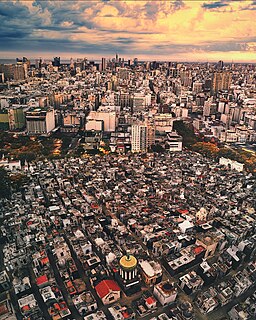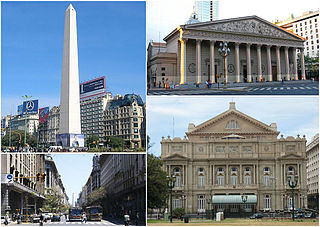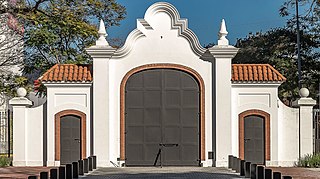- Carlos Acuña (1914–1999), tango singer, composer
- Aída Alberti (1915-2006), actress
- Alfredo Alcón (1930-2014), actor
- Oscar Alemán (1909-1980), jazz musician
- José Alonso (trade unionist), (1917–1970)
- José Amalfitani (1894-1969), president of the Vélez Sarsfield football team
- Alberto Anchart (1931-2011), actor
- Cosme Argerich (1758–1820), doctor and pioneer of military field medicine
- Manuel Argerich (1835–1871), physician, philosopher, lawyer
- Mirta Arlt (1923-2014), writer, professor, translator
- Emin Arslan (1868-1943), diplomat, writer, editor
- María Lorenza Barreneche (1926–2016), former First Lady of Argentina (Cremated at La Chacarita, burial in La Recoleta Cemetery) [1]
- Guillermo Battaglia (1899-1988), actor
- Nelly Beltrán (1925-2007), actress
- Paquita Bernardo (1900–1925), musician, tango composer
- Antonio Berni (1905-1981), painter
- Eduardo Vicente Bianco (1892–1959), tango composer and bandleader
- Eladia Blázquez (1931-2005), tango vocalist and composer
- Alejandra Boero (1918-2006), actress
- Oscar Bonavena (1942–1976), heavyweight boxer
- Ángel Borlenghi (1904-1962), trade-unionist and Peronist politician
- Sofía Bozán (1904-1958), actress and tango vocalist
- Alfredo Bravo (1925-2003), Socialist politician
- Alicia Bruzzo (1945-2007), actress
- Clemar Bucci (1920–2011), race car driver
- Enrique Cadícamo (1900–1999), author, tango lyricist
- Francisco Canaro (1888-1964), tango bandleader and composer
- Evaristo Carriego (1883–1912), poet, journalist
- Adolfo Castelo (1935-2004), news anchorman
- Alberto Castillo (1914–2002), tango singer
- Orestes Caviglia (1893-1971), stage director and actor
- Cátulo Castillo (1906–1975), musician, composer, poet, boxer
- Gustavo Cerati (1959-2014), rock singer, songwriter, composer, producer
- José Cibrián (1916-2002), stage director and actor
- Pascual Contursi (1888-1932), tango composer
- Carlos Cores (1923-2000), actor
- Juan d'Arienzo (1900–1976), orchestra leader
- Julio de Caro (1899-1980), tango bandleader and composer
- Juan de Dios Filiberto (1885-1964), tango composer
- Julio de Grazia (1929–1989), actor, director
- Alejandro De Michele (1954–1983), rock singer
- Carlos di Sarli (1903-1960), tango bandleader
- Guido di Tella (1931-2001), former Foreign Minister
- Torcuato di Tella (1892-1948), industrialist
- Edgardo Donato (1897-1963), tango composer
- Vito Dumas (1900-1965), navigator
- Ulises Dumont (1937–2008), actor
- Samuel Eichelbaum (1894-1967), writer
- Homero Expósito (1918-1987), tango lyricist
- Ada Falcón (1905-2002), tango vocalist
- Edelmiro Farrell (1887-1980), President of Argentina
- León Ferrari (1920-2013), conceptual artist
- Roberto Firpo (1884-1969), tango composer
- Norma Fontenla (1930-1971), prima ballerina
- Osvaldo Fresedo (1897-1984), bandoneónist and tango composer
- María Rosa Gallo (1925–2004), actress
- Leopoldo Galtieri (1926-2003), former President of Argentina
- Óscar Alfredo Gálvez (1913–1989), race car driver
- Ricardo Gamero (1938–1999), ventriloquist known as "Mister Chassman"
- Carlos Gardel (1890–1935), iconic tango singer, actor
- José María Gatica (1925–1963), boxer
- Carlos Enrique Gavito (1942–2005), tango dancer
- Severino Di Giovanni (1901–1931), Italian anarchist
- Enrique Gorriarán Merlo (1941-2006), founder of ERP terrorist group
- Roberto Goyeneche (1926–1994), tango singer
- Paul Groussac (1848–1929), French-born writer, historian
- Bernardo Houssay (1887–1971), Nobel Prize in Medicine
- José Ingenieros (1877-1925), physician and philosopher
- Maurice Jouvet (1923–1999), French-born actor
- Ángel Labruna (1918–1983), soccer player
- Lydia Lamaison (1914-2012), actress
| - Juan Carlos Lectoure (1936-2002), boxing promoter
- Inda Ledesma (1926–2010), actress
- Alfredo Le Pera (1900-1935), tango composer
- Irineo Leguisamo (1903–1985), thoroughbred racing jockey
- Antonio Vespucio Liberti (1900-1978), president of the River Plate football team
- Nélida Lobato (1934–1982), dancer
- María Loredo (1854-1928), faith healer
- Gianni Lunadei (1938-1998), actor
- Tito Lusiardo (1896-1982), tango dancer
- Pedro Maffia (1899-1967), bandoneónist
- Agustín Magaldi (1898–1938), tango vocalist
- Azucena Maizani (1902–1970), tango vocalist
- Homero Manzi (1907-1951), writer and tango composer
- Mona Maris (1903–1991), actress
- Duilio Marzio (1923-2013), actor
- Tita Merello (1904-2002), actress
- Lola Membrives (1888–1969), theater director and actress
- Alberto Migré (1931-2006), screenwriter
- Zully Moreno (1920–1999), actress
- Oscar Moro (1948-2006), rock drummer
- Jorge Newbery (1875–1914), pioneer aviator, sportsman
- Oscar Núñez (1929–2012), actor
- Alberto Olmedo (1933–1988), comedian
- Juan Carlos Onganía (1914-1995), former President of Argentina
- Pappo (1950–2005), musician (cremated here, his ashes were scattered in a Buenos Aires park)
- Mario Passano (1925-1995), actor
- Malvina Pastorino (1916-1994), actress
- Adolfo Pedernera (1918–1995), soccer player
- Ivo Pelay (1893–1959), poet, playwright
- Pascual Pérez (1926–1977), Olympic and World champion boxer
- Nathán Pinzón (1917-1993), actor
- Pablo Podestá (1875–1923), actor
- Jorge Porcel (1936–2006), comedian
- Javier Portales (1937-2003), comedian
- Osvaldo Pugliese (1905–1995), pianist
- Benito Quinquela Martín (1890–1977), painter
- Francisco Rabanal (1906-1982), former Mayor of Buenos Aires
- Pedro Pablo Ramírez (1884-1962), former President of Argentina
- Raúl Riganti (1893–1970), race car driver
- Edmundo Rivero (1911-1986), tango vocalist
- Nélida Roca (1929-1999), dancer
- José Ignacio Rucci (1924-1973), trade-unionist
- Luis Sandrini (1905–1980), comedian
- Enrique Santos Discépolo (1901-1951), tango composer
- Enrique Sdrech (1928-2003), journalist
- Mohamed Alí Seineldín (1933-2009), mutinous Army officer
- Enrique Serrano (1891-1965), actor
- Osvaldo Soriano (1943–1997), novelist
- Hugo Soto (actor) (1953-1994)
- Alfonsina Storni (1892–1938), poet
- Carlos Thays (1849-1934), landscape designer and urbanist
- Juan Carlos Thorry (1908–2000), actor, entertainer
- Cacho Tirao (1941-2007), guitarist
- Leopoldo Torre Nilsson (1924-1978), film director
- Lolita Torres (1930-2002), actress, singer
- Aníbal Troilo (1914–1975), musician
- Saúl Ubaldini (1936-2006), trade-unionist
- Augusto Vandor (1923-1969), trade-unionist
- Ángel Villoldo (1861-1919), the "father of Tango"
- Roberto Viola (1924-1994), former President of Argentina
- María Elena Walsh (1930-2011), poet and composer
- Héctor Yazalde (1946–1997), soccer player
- Tincho Zabala (1923-2001), comedian
- Marcos Zucker (1921–2003), actor
|
























